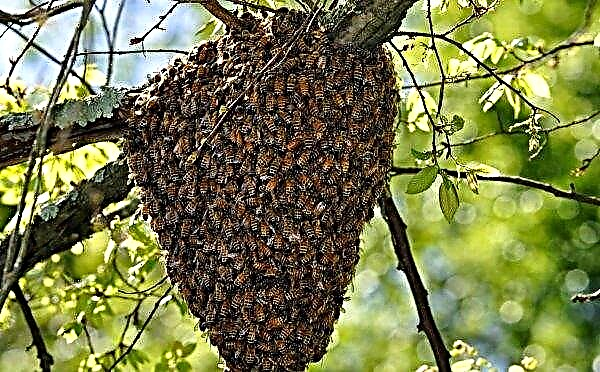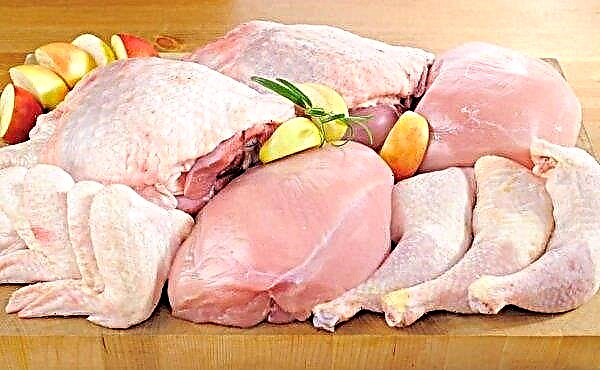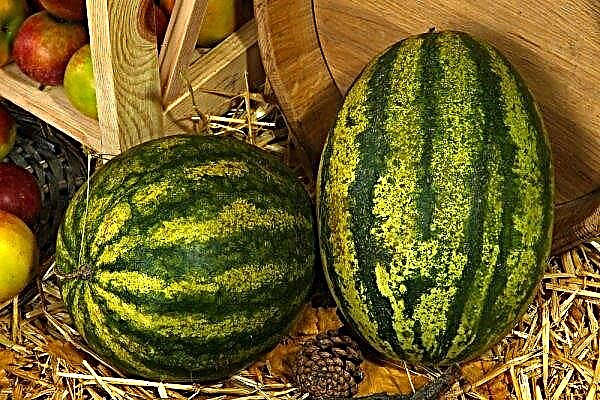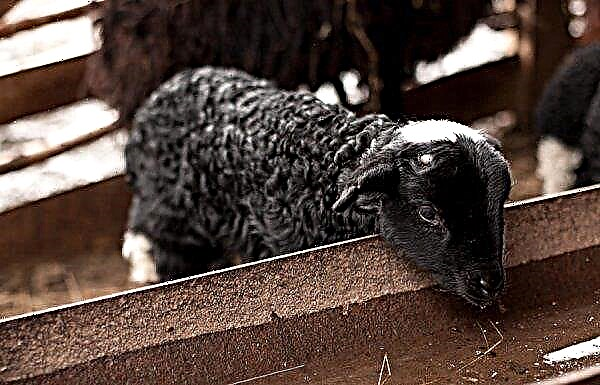Awareness of the causes of diseases, their ability to recognize and start treatment on time are important skills to maintain stable farm productivity. The term "dyspepsia" comes from a combination of Greek words translated as "lack of digestion", that is, this definition refers to a violation of the normal functioning of the intestine. The article will focus on dyspepsia of newborn calves, the conditions of its occurrence, diagnosis and treatment.
What is this disease?
Dyspepsia is a violation of the intestines. In relation to young growth it is indigestion of milk. In the colostrum period in a calf, many organs do not function well enough, including metabolic processes that are poorly balanced.
Ingestion of poor-quality colostrum, early weaning from a mother, or disturbances in the nutritional schedule lead to an upset in digestion and intoxication. The disease has a mild and toxic form.
Until recently, dyspepsia of newborn calves was not a separate disease and was considered common diarrhea of newborns. Now this is a separate disease with its clinical picture and treatment regimen. About 50% of newborn calves are affected. If treatment is not started on time, the calf may die. This happens in 20% of cases.
Development reasons
Among the causes of dyspepsia are noted:
- malnutrition of the cow during the dry season;
- insufficiently fatty and high-quality colostrum;
- antibiotic treatment of the cow;
- the inability of the stomach of the newborn to absorb food.
The conditions for the development of the disease are directly related. So, a cow that receives a defective, poor in trace elements and vitamins feed or an insufficient amount of it, is likely to give birth to a weakened calf. Moldy feed also cannot be fed during the dry season.
There are not enough antibodies in the baby’s blood. They will begin to come to him with colostrum of the mother. If within an hour after birth he does not receive colostrum, it is not enough or it turns out to be of low quality, then in his stomach incomplete assimilation of food will occur.
The stagnation that has begun will lead to the rapid development of opportunistic microorganisms and indigestion.
During the first week, the conditions contributing to the onset of the disease are:
- belated first calf binge (later than 1 hour after birth);
- early cessation of colostrum feeding;
- milk milk of a cow treated with antibiotics;
- early conversion to concentrated feed.
 If the cow continues to be on an unbalanced diet, this can also cause dyspepsia.
If the cow continues to be on an unbalanced diet, this can also cause dyspepsia.Did you know? The cause of dyspepsia can be not only poor-quality or untimely nutrition, but also elementary stress in the animal.
Forms of the disease
There are 2 forms of the disease:
- Simple. With this form, the baby maintains a good appetite in the presence of an intestinal upset. The temperature is within the physiological norm (38.8–39.6 ° С). At this stage, the disease is well treated and has a positive prognosis.
- Toxic In this form, there is no appetite, the animal is depressed, a decrease in body temperature (up to 35 ° C), tremors, dull corneas of the eyes are observed. Liquid feces with a sharp unpleasant odor and an abundance of mucus. The color of feces varies from yellow to green, spotting may be observed. A blood test should show a decrease in ESR, a decrease in white blood cells and a decrease in microelement composition below normal (potassium, sodium). In the absence of timely treatment, the calf can die from general intoxication and loss of fluid by the body.
The mechanism of the origin and development of the disease in calves
The scar (one of the pre-stomachs) of a newborn calf is not sufficiently developed anatomically and cannot fully digest food. Microflora in the early days is just beginning to form. If pathogens enter the intestines, then this adversely affects digestion.
Retention of milk in the intestine will cause the development of putrefactive processes. Microorganisms begin to affect the intestinal wall and cause irritation of the mucous membrane, inflammation and poisoning of the body by toxins. As a result of irritation of the abomasum and intestines, the animal loses its appetite and becomes lethargic. He begins diarrhea, accompanied by dehydration.
Microorganisms begin to affect the intestinal wall and cause irritation of the mucous membrane, inflammation and poisoning of the body by toxins. As a result of irritation of the abomasum and intestines, the animal loses its appetite and becomes lethargic. He begins diarrhea, accompanied by dehydration.
Gradually, the calf begins to weaken, the electrolyte composition of the fluid is disrupted, which leads to degenerative changes in the liver and kidneys. Along with this, the work of the heart and other body systems is disrupted.
Did you know? Food moves in the esophagus of mammals due to peristalsis. This mechanism can deliver food to its destination, even if it is hung upside down.
Symptoms
Immediately after the onset of the disease, the calf becomes inactive and partially loses its appetite. Body temperature and body condition at this time will be normal. There is no diarrhea at this moment. It starts on the second day. The calf is lying more. You can also hear the characteristic rumbling of the intestines.
If you do not start treatment, then the condition will be aggravated due to poisoning of the body by the decay products of milk fermented in the stomach. At this stage, toxic dyspepsia will begin.
Her symptoms:
- eyes grow dull;
- dry nose;
- the mucous membranes turn blue;
- body temperature drops to 35–37 ° C;
- the calf often trembles due to intestinal cramps;
- the body is sluggish;
- breathing quickens;
- the load on the heart increases and the pulse quickens;
- the animal refuses food;
- the coat becomes dull;
- feces become liquid with a splash of mucus and an unpleasant odor;
- around the anus, sticky wool is observed in the remains of feces.
 In the advanced stage, diarrhea practically does not stop. The animal begins to fall into a coma. The duration of the disease in mild form is 2-3 days, in severe - up to 1 week.
In the advanced stage, diarrhea practically does not stop. The animal begins to fall into a coma. The duration of the disease in mild form is 2-3 days, in severe - up to 1 week.Did you know? Intestinal gas is a combination of swallowed air and gases produced by the fermentation of food by bacteria in the gastrointestinal tract. Bacteria in the process emit carbon dioxide, hydrogen, methane and hydrogen sulfide. Therefore, stool smells bad.
Diagnostics
A veterinarian can diagnose the condition by the general condition of the calf and based on the results of a blood test. They will show a violation of the electrolyte composition with a decrease in potassium, a decrease in white blood cell count and ESR.
Additional factors in the diagnosis are cattle nutrition analysis and virological examination. His task is to exclude the infectious and bacteriological nature of the condition of the calf and the appointment of the correct course of treatment.
Pathological changes
The toxic form results in the death of the animal in 25% of cases.
At the autopsy of the dead calf, they state:
- severe fluid loss;
- contaminated wool around the anus;
- pale sclera of the eyes;
- cyanotic mucous membranes of the mouth;
- swollen vessels of maroon color;
- heart with multiple point hemorrhages, increased size;
- edematous lungs with foci of congestive hyperemia;
- bile is dark green;
- the scar contains a gray-green putrefactive liquid with an unpleasant odor;
- dense curved clots are found in the abomasum;
- there are multiple small hemorrhages on the organs.

How to treat?
For the treatment of a simple stage of the disease, the following rules are followed:
- drinking the next two servings of colostrum is canceled;
- give a warm saline solution (1% sodium chloride solution).
After 12 hours, the intestinal condition should normalize. If diarrhea has stopped, then the frequency of feedings is increased by 2 times, reducing the serving volume by half.
At the same time, the activity of gastric juice increases, the volume of amino acids decreases, which contribute to the development of pathogenic microflora due to the high content of carbohydrates. Within a week, the food is returned to normal and 500 ml of saline solution at room temperature are soldered to the animal before each feeding.
Important! Glucose cannot be replaced with sugar. Cattle do not digest regular sugar, and this will complicate the condition of the calf.
For toxic form:
- colostrum is also canceled;
- instead of colostrum, the first day gives saline to restore the digestive process and restore water balance;
- from the second day, the daily norm of colostrum is reduced by half and given in equal portions 4 times a day;
- a course of antibiotics is prescribed to suppress the development of putrefactive microflora (these can be drugs of the tetracycline group);
- sulfanilamides may be prescribed to combat bacterial infection.
Acceptance of drugs is carried out in a dosage prescribed by a specialist. Good results are shown by a complex with alternating antibiotics and sulfonamides. Drugs must be given orally. So they quickly enter the intestines and have a stronger effect than when absorbed through the blood. In addition, symptomatic treatment will be used. To reduce intoxication, glucose is prescribed.
Drugs must be given orally. So they quickly enter the intestines and have a stronger effect than when absorbed through the blood. In addition, symptomatic treatment will be used. To reduce intoxication, glucose is prescribed.
When dehydrated, an isotonic sodium chloride solution is used subcutaneously. As the condition improves, the calf is returned to normal consumption.
Nutrition correction
When the first signs of dyspepsia appear, colostrum is canceled. It is replaced by saline (1% sodium chloride solution) with a temperature close to the body temperature - 38 ° С. Over the next 3-4 days, the calf is at half normal colostrum.
Instead of the second half, saline is used. It is also recommended to give the calf a decoction of medicinal herbs - alder cones, oak bark, elecampane and enveloping decoctions (rice). Within a month after dyspepsia, they continue to give saline and gradually return the amount of milk to normal.
Important! All types of fluids should be given only through the nipple. This will prevent large quantities of milk from being swallowed and ensure that dyspepsia does not recur.
Blockade of novocaine
Novocainic blockade is used to relieve a pronounced pain syndrome by introducing an anesthetic into a sore spot. As an anesthetic, novocaine, lidocaine, B vitamins, glucocorticoids can act. The choice of the drug or their combination depends on how long you need to anesthetize the site and how intense the pain is.
The choice of the drug or their combination depends on how long you need to anesthetize the site and how intense the pain is.
The area that is anesthetized is the gastrointestinal tract. For injection, you can apply a 0.5% solution of novocaine in a dosage of 1 ml per 1 kg of calf weight. An injection is made into the right hungry fossa, after having fixed the animal. The needle is immersed deep enough - 20-30 mm.
The drug is administered slowly. The blockade quickly suppresses the focus of the disease.
Important! Novocainic blockade has no side effects, so it can be used repeatedly.
Compensatory treatment
Compensatory is the treatment in which the functions of a diseased organ are compensated by another organ. In this case, it is necessary to compensate for the intestinal microflora. For this, the animal can be given a 50% solution of gastric juice 20 minutes before feeding.
Dosage: Dissolve 50 g of pharmacy gastric juice in 150 g of warm water. Gastric juice will have a stimulating effect on the intestines and help accelerate recovery.
Functions of the gastric juice:
- Replenishment of arising deficiency of food enzymes;
- stimulation of the pancreas and the production of its own gastric juice;
- regulation of acid-base balance;
- restoration of intestinal microflora;
- digestive system disinfection;
- increase the digestibility of milk.
 To restore the water-electrolyte balance and prevent dehydration, the calf will need an electrolyte solution. You can purchase ready-made preparations - Regidron, Rediar, Antidiareiko, Ringer's solution or prepare the mixture yourself.
To restore the water-electrolyte balance and prevent dehydration, the calf will need an electrolyte solution. You can purchase ready-made preparations - Regidron, Rediar, Antidiareiko, Ringer's solution or prepare the mixture yourself.For cooking, you will need to dissolve 3.5 g of salt (1.3 tsp), 5 g of baking soda (1 tsp) 3.5 g of potassium carbonate and 10 g of glucose in 1 liter of water. Solder gradually, in small portions. To enhance the effect, the solution can be prepared on a decoction of oak bark.
Specific therapy
Usually the use of dietary therapy, the use of decoctions and methods of compensatory therapy is enough to stop the disorder. But if the situation is complicated by an infectious or bacterial infection, then the use of antibiotics, sulfonamides and nifurans will be required.
Antibiotics can be prescribed only by a specialist, this will prevent a possible overdose or improper use of the drug. Tetracycline is most commonly used to treat dyspepsia. It copes with any infections perfectly.
The course will consist of 4 days with the drug 3-4 times a day. Tetracycline is prescribed at the rate of 0.0.1-0.02 mg per 1 kg of body weight.
Sulfanilamides have an antibacterial effect. They also relieve inflammation and reduce the formation of toxins. Since an increased dose of sulfonamides will be toxic to the animal, a veterinarian also prescribes them.
This group includes sulgin, phthalazole, sulfadimesin, phthazine. A single dose is 0.02-0.03 mg per 1 kg of animal weight. Apply for 3-4 days, 3 times a day. Nitrofurans are used to treat gram-negative and gram-positive bacteria, including coccidia and fungal infections. This group includes furatsilin, furazolidone, furagin and other drugs. The course of treatment lasts 3-4 days. Dosage: 0.005-0.007 mg per 1 kg of weight 3 times a day. These drugs are also prescribed by a doctor.
Nitrofurans are used to treat gram-negative and gram-positive bacteria, including coccidia and fungal infections. This group includes furatsilin, furazolidone, furagin and other drugs. The course of treatment lasts 3-4 days. Dosage: 0.005-0.007 mg per 1 kg of weight 3 times a day. These drugs are also prescribed by a doctor.
Important! Preparations are stored in a place protected from sunlight in hermetically sealed vials. Nitrofurans under the influence of the sun are destroyed, so they are packed in bottles of dark glass.
Folk remedies
Treatment of calf with folk remedies involves the use of decoctions of medicinal herbs and enveloping decoctions.
They are prepared by languishing in an oven or over low heat for 20-30 minutes. Decoctions prepared by pouring medicinal raw materials in a thermos for 20-30 minutes are also effective. Dosage: a handful of plant material in 2 liters of water.
For this purpose, herbs with astringent action are used, such as:
- St. John's wort
- Oak bark;
- alder cones;
- elecampane;
- horse sorrel root.
For enveloping broths, rice, oatmeal, and flax seeds are used. A handful of raw materials is boiled in 2 liters of water. For oatmeal, the cooking time is 10 minutes, for rice and flax - 30 minutes over low heat. The broth is slightly salted to improve its electrolyte properties and given to calves 3-4 times a day for 200 g.
Prevention
Prevention of dyspepsia begins with proper feeding of the cow during the dry period. In terms of preventive measures, it is necessary to carefully observe the following rules:
In terms of preventive measures, it is necessary to carefully observe the following rules:
- At the deadwood stage, the cow must accumulate a sufficient amount of vitamins and minerals for the full formation of the fetus and labor. After calving, the cow continues to receive balanced feed.
- It is undesirable to treat a dairy cow with antibiotics - they increase the risk of dyspepsia in the calf.
- The barn must comply with hygiene standards. Air temperature should not be excessively high in summer or low in winter.
- If an infected animal appears in the herd, it must be isolated in the quarantine zone to prevent the spread of infection.
- They begin to drink calf with colostrum no earlier than an hour after giving birth. Colostrum should be from a healthy cow.Within 24 hours after birth continue to give colostrum with an interval of 3-4 hours.
Any disease is easier to prevent than to cure. Observing preventive measures, you will prevent up to 70% of outbreaks of all diseases. But if the calf is still ill, then start treatment from the moment the symptoms are detected.












